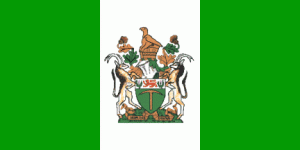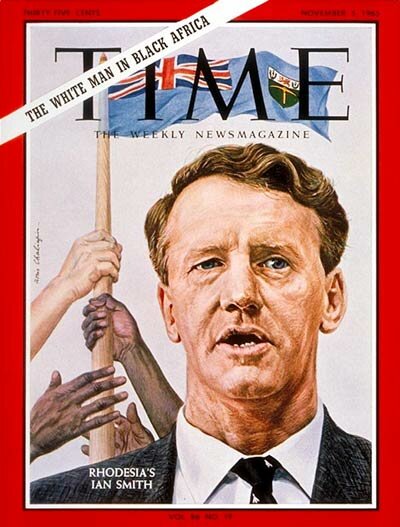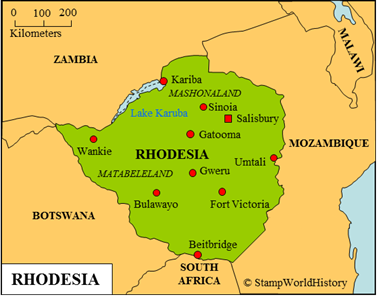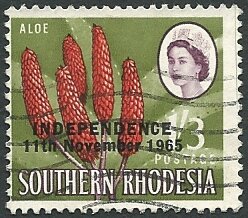
Rhodesia
Quick reference
General issues: British colony, self government 1964-1965, Unilaterally declared independence within the British Commonwealth 1965-1970, Unilaterally declared independence as a republic 1970-1979
Country name on general issues: Rhodesia
Currency: 1 Pound = 20 Shilling, 1 Shilling = 12 Pence 1964-1970, 1 (Rhodesian) Dollar = 100 Cent 1970-1979
Population: 4 350 000 in 1964
Political history Rhodesia
Rhodesia is located in eastern Africa. In the mid 19th century, Mashonaland and Matabeleland are the two most important kingdoms in the future Rhodesia. The British establish a presence, from 1889, through the British South Africa Company. The British South Africa Company is a chartered company. The charter of the British South Africa Company encompasses a territory that, from 1895, will come to be called Rhodesia – a term that is used at the time in a geographical sense rather than to identify a political entity: the territory of the British South Africa Company has yet to be colonized and political entities have yet to be formed. The British South Africa Company sets to work by signing treaties with the kings of Mashonaland and Matabeleland in 1890. Subsequently these are proclaimed protectorates by the British government in 1891.
As the British South Africa Company gains control over more and more territory, the administrative divisions are frequently changed. Eventually, two protectorates are formed in 1911: Northern Rhodesia – the current Zambia – and Southern Rhodesia – the future Rhodesia as discussed in this profile.

Ian Smith -Prime minister of Rhodesia 1964-1979
The charter of the British South Africa Company ends in 1924. Just prior to that, in 1923, the administration of Southern Rhodesia is transferred to the British government, Southern Rhodesia becoming a British colony. From 1953 until 1963, Southern Rhodesia is part of the federation of Rhodesia & Nyasaland that also incorporates Northern Rhodesia and Nyasaland. When the federation is dissolved, Southern Rhodesia once again becomes a British colony, now with self government. Without the consent of the British, the name of the country is, upon this occasion, changed from Southern Rhodesia to Rhodesia.
The government of Rhodesia, in 1964, is elected by and formed from the white minority in Rhodesia. The British have stipulated, as a precondition for full independence, that general elections be held, including the majority of the black population. To continue the privileged position of the white minority, Rhodesia, in 1965, unilaterally declares independence – initially with the intention to stay within the British Commonwealth. This declaration of independence is not recognized – not by the British nor by the international community. The United Nations imposes economic sanctions. As the British continue to deny recognition for an independent Rhodesia, Rhodesia, in 1970, declares full independence as the republic of Rhodesia, thus exiting the British Commonwealth.
Meanwhile, the black population has begun to organize itself and has started a guerrilla war – often called the Rhodesian Bush War. The war, and the continuing international pressure, in 1979 lead to concessions of the government. Finally, in late 1979, parties reach an agreement. Colonial rule will be reestablished to prepare general elections that are held in 1980. The name of the country is changed to Zimbabwe-Rhodesia in 1979 and, in 1980, to Zimbabwe as we know it until today. The republic of Zimbabwe will gain international recognition.
For a country diagram showing the political developments please refer to the diagram of British Central Africa.
Postal history Rhodesia
The first stamps used in Rhodesia are, from 1890, the issues of the British South Africa Company. Next, from 1925 the stamps of Southern Rhodesia are used, and from 1954 the issues of the federation of Rhodesia & Nyasaland. Stamps of Southern Rhodesia will again be used from 1964. Rhodesia will issue its first stamps in 1965 – first as a British colony, later, in 1965, as independent Rhodesia and from 1970 as the republic of Rhodesia. From 1980, the stamps of Rhodesia are superseded by those of Zimbabwe.
Album pages
← Previous page: RéunionNext page: Rhodesia & Nyasaland →




